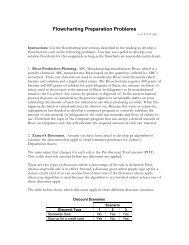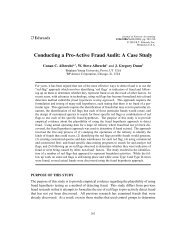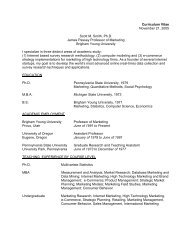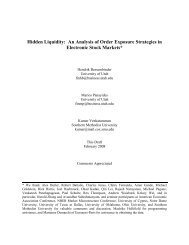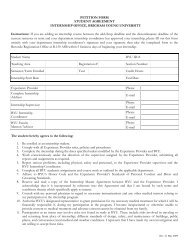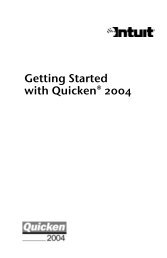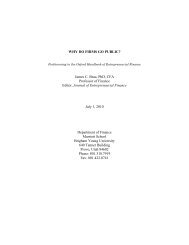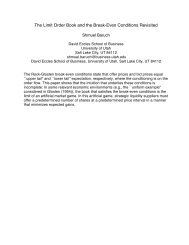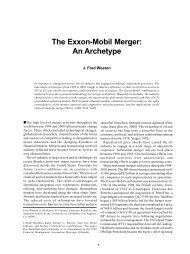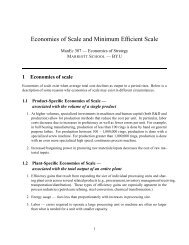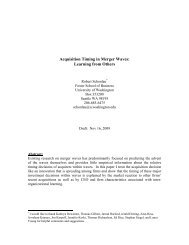Albrecht 19.pdf - Marriott School
Albrecht 19.pdf - Marriott School
Albrecht 19.pdf - Marriott School
Create successful ePaper yourself
Turn your PDF publications into a flip-book with our unique Google optimized e-Paper software.
76154_23_ch19_p942-1006.qxd 3/1/07 3:35 PM Page 954<br />
954 Part 6 Control in a Management Accounting System<br />
CAUTION<br />
the standard quantity of inputs allowed for actual output. The important concept is quantity<br />
allowed for actual output. This concept refers to the quantity of materials that should<br />
have been used to produce the actual output and relates back to the principle of flexible<br />
budgeting that we discussed in the expanded material section of Chapter 18. Simply put,<br />
Sunbird management must wait until the end of the year to determine how many feet of<br />
wood it should have used during the year. At the end of the year, the accountant for<br />
Sunbird Boat Company will multiply the standard quantity of materials per boat by the<br />
actual volume of boats produced to determine the standard quantity allowed or:<br />
Standard quantity per unit Actual units produced = Standard quantity allowed<br />
As you can see in the illustration on the previous<br />
page, when the actual quantity used is the<br />
basis for the materials price variance, the materials<br />
price variance and the materials quantity<br />
variance share some of the same computations,<br />
making these calculations somewhat easier.<br />
However, remember that basing the materials<br />
price variance on the actual quantity used will<br />
delay the recognition of price problems from<br />
the time that the materials are purchased until<br />
the time they are transferred to production.<br />
FYI<br />
This number is then compared to the actual<br />
quantity of wood used to determine if there<br />
is a favorable or unfavorable quantity variance<br />
for materials. The accountant will multiply<br />
this variance by the standard price for<br />
wood in order to account for this variance<br />
in Sunbird’s accounting system (which we<br />
discuss later in this section).<br />
In the fast-food arena, for example, franchises,<br />
such as McDonald’s and Baskin-Robbins,<br />
have standard quantities for meat in hamburgers,<br />
ice cream in cones, and the amount of<br />
time it should take to serve a customer.<br />
Controlling Materials Variances<br />
Materials price variances are usually under<br />
the control of the purchasing department.<br />
The purchasing function involves getting a<br />
variety of price quotations, buying in economic<br />
lot sizes to take advantage of quantity<br />
discounts, paying on a timely basis to obtain<br />
cash discounts, and evaluating alternative forms of delivery to minimize shipping costs.<br />
Some of these factors will be less important when there are few suppliers or when purchase<br />
contracts with suppliers are for long periods. In any case, the existence of unfavorable<br />
price variances may suggest a problem that needs correcting. On the other hand,<br />
favorable price variances may also indicate that there is a problem in the purchasing<br />
process, such as the purchase of lower quality materials or purchasing too much material<br />
in order to get a larger bulk discount.<br />
The buyer responsible for purchases should be able to explain any variance from standard<br />
price even though the buyer may not be able to control its occurrence. This may be<br />
the case, for example, when market prices change after the standard is set, which could<br />
be the explanation for the favorable price variance. Or materials may be damaged, requiring<br />
the reorder of a small quantity on a rush basis; this usually raises the price of the materials<br />
as well as the cost of shipping, causing an unfavorable price variance. The point is that the<br />
cause of any significant variance (whether favorable or unfavorable) must be explained and<br />
steps taken to avoid such variances in the future. The purpose of variance analysis is not to<br />
browbeat employees for failing to meet impossible expectations, but rather to provide information<br />
that will help management identify ways of improving the production process.<br />
Materials quantity variances may be caused by quality defects, poor workmanship,<br />
poor choice of materials, inexperienced workers, machines that need repair, or an inaccurate<br />
materials quantity standard. Just as the purchasing manager must explain significant<br />
price variances, generally the<br />
production manager must analyze significant<br />
quantity variances to determine their<br />
cause. If the material is of inferior quality,<br />
the purchasing manager, rather than the<br />
production manager, may be responsible<br />
for the variance. Again, the point is that the<br />
cause of the variance must be determined;<br />
only then can it be decided what action, if



